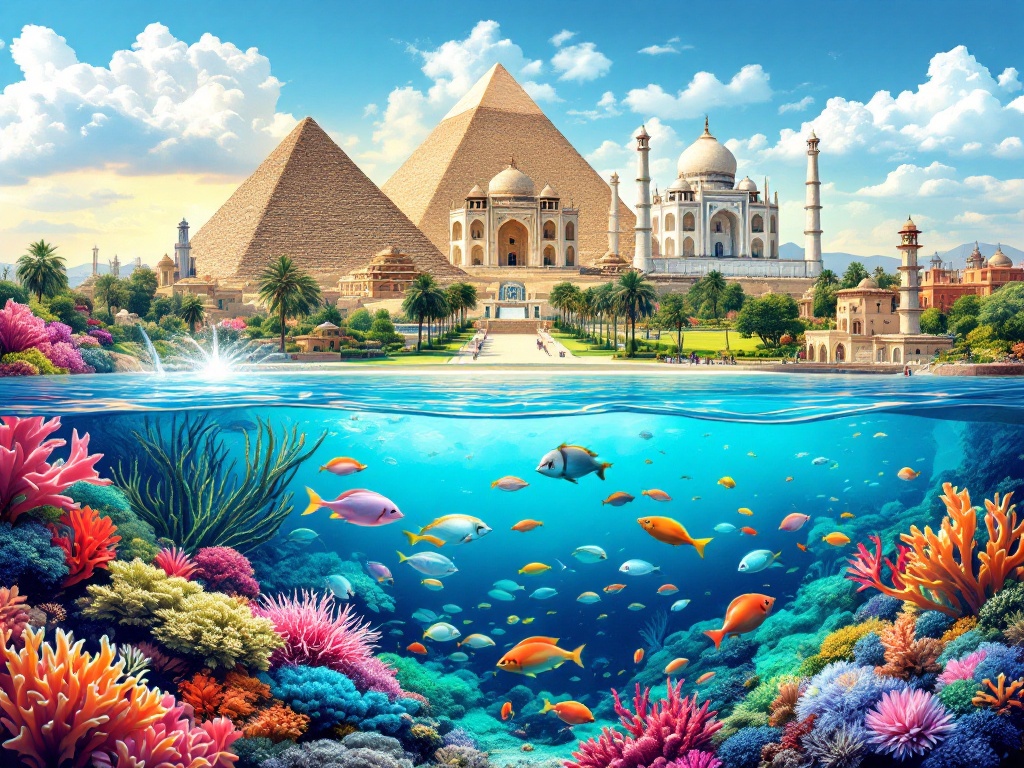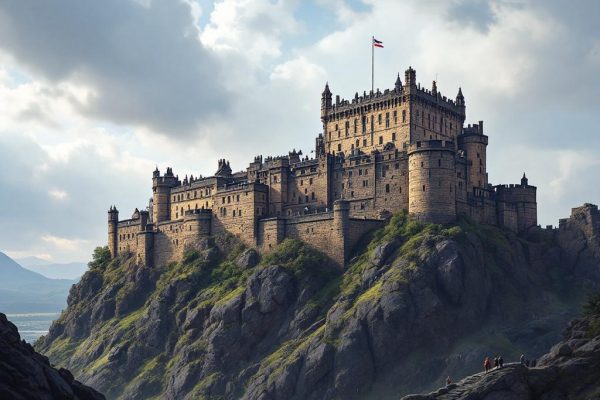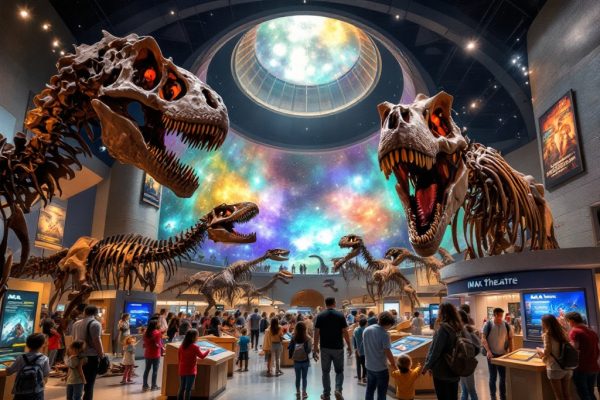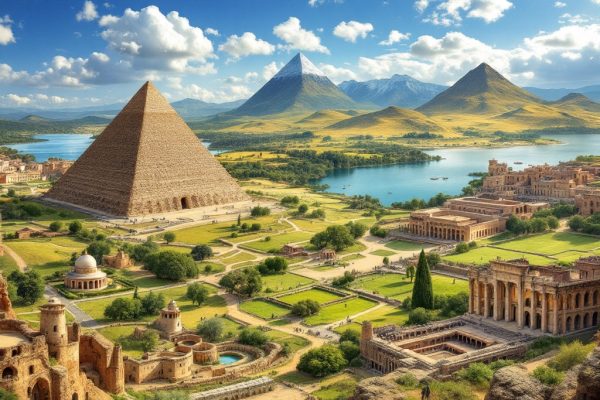What Are The World Heritage Sites
Discover the wonders of World Heritage Sites, landmarks of “Outstanding Universal Value” crucial to human history and the natural world. From the Pyramids of Giza to the Great Barrier Reef, these treasures, chosen for cultural, historical, or scientific significance, face threats like climate change and urban development. Explore the rigorous selection process, the importance of international cooperation, and how we can protect this shared legacy for future generations. Dive in to learn more about these iconic places and their preservation.
Important information

- World Heritage Sites are places of cultural, historical, or scientific significance, possessing “Outstanding Universal Value”.
- Sites are inscribed on the World Heritage List after a rigorous evaluation process by experts.
- Threats to these sites include climate change, urban development, tourism, and lack of funding.
- The “World Heritage in Danger List” highlights sites facing immediate threats and promotes preservation efforts.
- Host countries are responsible for the long-term protection and management of inscribed sites within their borders.
What Defines World Heritage Sites?
World Heritage Sites are exceptional places, celebrated for their cultural, historical, or scientific significance. These landmarks possess “Outstanding Universal Value,” signifying their embodiment of pivotal moments in human history or awe-inspiring natural phenomena. Due to their global importance, these treasures are safeguarded by international accords. A site achieves World Heritage listing only after rigorous evaluation by experts, who assess it against stringent criteria for both cultural and natural heritage.
These distinguished sites showcase remarkable human creativity, offer unique glimpses into cultural traditions, and demonstrate important exchanges of human values.
Some illuminate significant periods of human history.
Others, scientifically invaluable, reveal vital ecological and biological processes.
The core principle of Outstanding Universal Value underscores a site’s significance, transcending national boundaries and holding profound meaning for all of humanity, both present and future. This shared heritage belongs to us all.
Cultural, Historical, and Scientific Significance
World Heritage Sites are vital landmarks, chosen for their immense cultural, historical, and scientific significance. They embody remarkable human accomplishments and must meet rigorous criteria to demonstrate outstanding universal value—meaning their importance transcends borders and cultures.
Outstanding Universal Value
A site’s Outstanding Universal Value signifies its cultural, historical, or scientific significance to humanity. This essential principle is the cornerstone for inclusion on the World Heritage List, safeguarding globally important landmarks and areas of exceptional value.
How Are World Heritage Sites Nominated and Inscribed?
The process of becoming a World Heritage site involves several steps:
A country submits its proposed location to a Tentative List.
The World Heritage Centre reviews the proposed site.
The Centre evaluates the site against criteria for Outstanding Universal Value.
The World Heritage Committee makes a final decision on inscription based on the Centre’s assessment.
The entire process can take several years.
Selection Criteria for Inscription
A location must meet specific criteria to become a World Heritage site. There are two types of criteria:
Cultural Significance
Six criteria exist for cultural significance.
Natural Value
Four criteria exist for natural value.
Some sites possess both, but only one is required for qualification.
Nomination Process and Timeframe
The process begins with a country’s government identifying a site of potential world heritage significance and preparing a detailed proposal for submission to the World Heritage Committee.
This proposal outlines the site’s significance, details management plans, and describes strategies for its long-term protection.
Experts rigorously evaluate the submitted proposal, conducting a thorough review of the provided information.
A field visit to the proposed site is conducted to allow experts to perform an on-site assessment, gathering first-hand information and verifying the details presented in the proposal.
The World Heritage Committee convenes during its annual session to deliberate and decide whether the nominated site meets the criteria for inclusion on the World Heritage List.
Role of the Host Country
A nation identifies potential sites within its borders for World Heritage listing.
A detailed nomination dossier is prepared for each selected site, outlining its significance and meeting UNESCO’s criteria.
The dossier is submitted to UNESCO for evaluation and consideration.
If the site is inscribed on the World Heritage List, the host country assumes responsibility for its long-term protection.
Ongoing management and preservation efforts are implemented to maintain the site’s “Outstanding Universal Value” for future generations.
Examples of Iconic World Heritage Sites
The Pyramids of Giza, incredible feats of ancient Egyptian engineering, hold immense historical significance as tombs.
Pompeii, a Roman city frozen in time by a volcanic eruption, offers a unique glimpse into ancient daily life.
Indonesia’s Borobudur Temple, a 9th-century Mahayana Buddhist monument, is renowned for its intricate carvings and impressive architecture.
Angkor Wat, a vast temple complex in Cambodia dedicated to Vishnu, stands as a Khmer architectural masterpiece and symbolizes the country’s rich history.
Built by a Mughal emperor for his wife, India’s Taj Mahal is celebrated for its stunning beauty and intricate marble work.
The opulent Palace and Gardens of Versailles, once the French royal residence, symbolize the monarchy’s extravagance.
Schönbrunn Palace in Vienna, the Habsburg emperors’ summer residence, exemplifies Baroque architecture.
Robben Island, a South African island and former prison, symbolizes the struggle against apartheid and human resilience.
Off Australia’s coast, the Great Barrier Reef, a vast coral reef system, is one of Earth’s most biodiverse ecosystems.
The Galápagos Islands, a volcanic archipelago in the Pacific, are famous for their unique wildlife and played a crucial role in Darwin’s theory of evolution.
Carved by the Colorado River, Arizona’s Grand Canyon is a geological wonder showcasing Earth’s history.
The Acropolis in Athens, home to iconic structures like the Parthenon, represents the pinnacle of classical Greek architecture and embodies Greek civilization.
Pyramids of Giza
The majestic Pyramids of Giza, located on Egypt’s Giza plateau near Cairo, served as tombs for Fourth Dynasty pharaohs. These ancient wonders offer a glimpse into ancient Egyptian civilization. The site includes the Great Pyramid of Khufu, the Pyramid of Khafre, and the Pyramid of Menkaure, along with the Great Sphinx and other complexes. These incredible feats of engineering and architecture demonstrate astounding precision, evident in their alignment with the cardinal points and intricate internal chambers. These features reveal the ancient Egyptians’ advanced understanding of astronomy and complex construction techniques. As enduring symbols of this ancient world, the Pyramids of Giza hold immense cultural and historical significance, illuminating ancient Egyptian beliefs, rituals, and social structures.
Archaeological Areas of Pompeii
Pompeii, an ancient Roman city, offers a unique glimpse into Roman life, frozen in time by the eruption of Mount Vesuvius in 79 AD. The volcanic ash entombed the city, preserving homes, public spaces, art, and artifacts. This exceptional preservation provides valuable insights into Roman society, allowing us to understand their culture and experience how they lived. Pompeii truly is a window to the past.
Borobudur Temple
Located near Yogyakarta on the Indonesian island of Java, the 9th-century Borobudur Temple Compounds is the world’s largest Buddhist temple. This magnificent Mahayana Buddhist monument features an impressive structure of nine stacked platforms—six square and three circular—crowned by a central dome. Its walls are adorned with 2,672 relief panels and 504 Buddha statues. Recognized as a UNESCO World Heritage Site, Borobudur remains a significant pilgrimage destination for Buddhists worldwide.
Angkor Wat
Angkor Wat, the world’s largest religious monument, powerfully symbolizes Cambodia’s rich cultural heritage.
Taj Mahal
The Taj Mahal, an ivory-white marble mausoleum in Agra, India, stands as a testament to eternal love. Commissioned in 1632 by Mughal emperor Shah Jahan, it houses the tomb of his beloved wife, Mumtaz Mahal. A recognized UNESCO World Heritage Site, the Taj Mahal epitomizes Mughal architecture, seamlessly blending Islamic, Persian, Ottoman, and Indian influences. Its beauty is truly breathtaking.
Palace and Gardens of Versailles
The magnificent Palace of Versailles and its gardens epitomize the grandeur of French Baroque architecture and landscape design. For over a century, Versailles served as the heart of French royalty, beginning in 1682 when Louis XIV relocated the court there. It remained the primary royal residence until the start of the French Revolution in 1789, under Louis XVI, marking a pivotal moment in French history.
Schönbrunn Palace
Vienna’s historic Schönbrunn Palace is a must-see, boasting stunning gardens and magnificent Baroque architecture.
Robben Island
Robben Island is a powerful symbol of South Africa’s fight against apartheid and the resilience of its people. Nelson Mandela’s imprisonment there made the island a lasting symbol of resistance.
Great Barrier Reef
The Great Barrier Reef, the world’s largest coral reef system, is a breathtaking marvel composed of over 2,900 individual reefs and 900 islands. Stretching over 2,300 kilometers off Australia’s Queensland coast, this vast ecosystem covers approximately 344,400 square kilometers within the Coral Sea. Its stunning beauty is matched by exceptional biodiversity, supporting over 1,500 fish species, 411 types of hard coral, and a third of the world’s soft corals. It provides a habitat for diverse creatures, from dugongs and green sea turtles to a variety of shark species.
Galápagos Islands
The Galápagos Islands, a volcanic archipelago in the Pacific Ocean, belong to Ecuador. Famous for their unique species, the islands played a pivotal role in Charles Darwin’s development of evolutionary theory after his visit on the *Beagle*. This remarkable ecosystem is also a designated UNESCO World Heritage site.
Grand Canyon
Carved by the Colorado River, Arizona’s Grand Canyon is a breathtaking, immense chasm. Its steep sides reveal millions of years of geological history, each layer of rock whispering tales of the past.
Acropolis
Perched atop a rocky Athenian hill, the Acropolis, an ancient citadel, houses the remnants of remarkable structures, most notably the Parthenon. These architectural and historical marvels stand as a potent symbol of classical Greece, embodying its achievements in democracy, philosophy, and art. This significance was recognized in 1987 when UNESCO designated it a World Heritage site.
What Challenges Do World Heritage Sites Face?
World Heritage Sites face numerous serious threats, including mass tourism, pollution, natural disasters, and the impacts of climate change. Armed conflicts, looting, vandalism, and inadequate management further endanger these irreplaceable treasures. Climate change, in particular, leads to rising sea levels, extreme weather events, and increased temperatures, all of which severely impact these important locations. Urban development also poses a significant challenge, encroaching on surrounding buffer zones and disrupting both the visual integrity and ecological balance of these sites. The “World Heritage in Danger List” identifies sites facing immediate peril, prompting corrective measures and encouraging international preservation support. These combined efforts are essential to safeguarding our shared global heritage.
Impact of Climate Change and Urban Development
World Heritage sites face severe threats from climate change. Rising sea levels erode delicate coastlines. Extreme weather events are increasing in frequency, causing substantial damage. Human activities exacerbate these natural forces. For instance, urban development contributes to pollution and encroachment, further straining these invaluable treasures. Protecting them requires immediate action. Here’s a breakdown of the key threats and the actions needed:
Climate Change Impacts
- Rising sea levels erode coastlines, threatening coastal heritage sites.
- Extreme weather events, like storms and floods, are becoming more frequent and intense, causing significant damage.
- Changing temperatures and precipitation patterns can destabilize structures and ecosystems.
Human Activities
- Urban development and encroachment put pressure on heritage sites, leading to pollution and habitat destruction.
- Tourism, while economically beneficial, can contribute to overcrowding and environmental degradation if not managed sustainably.
- Lack of funding and resources hinders effective conservation efforts.
Protecting these sites requires a multi-pronged approach. International cooperation, sustainable tourism practices, and increased funding for conservation are crucial. We must act now to preserve our shared heritage for future generations.
World Heritage in Danger List
The World Heritage in Danger List identifies threatened sites facing serious perils that jeopardize their unique global significance, known as “Outstanding Universal Value.” Loss of this value could result in delisting from World Heritage status. The list raises international awareness and promotes preservation efforts.














